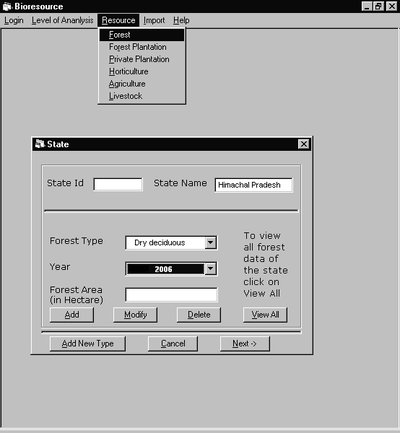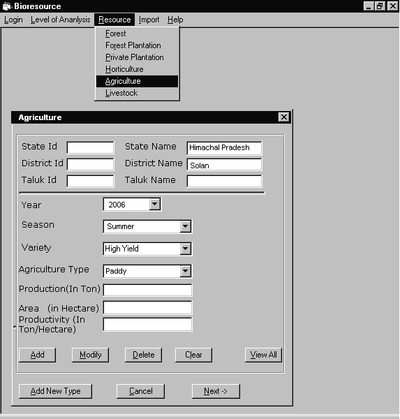 |
REGIONAL BIOENERGY PLANNING FOR SUSTAINABILITY IN HIMACHAL PRADESH, INDIA |
 |
Ramachandra T V 1,2,3,* Gautham Krishnadas1 Bharath Setturu 1 Uttam Kumar 1
1 Energy & Wetlands Research Group, Center for Ecological Sciences [CES],
Indian Institute of Science, Bangalore, Karnataka, 560 012, India
2 Centre for Sustainable Technologies (astra), Indian Institute of Science, Bangalore, Karnataka, 560 012, India
3 Centre for infrastructure, Sustainable Transportation and Urban Planning [CiSTUP],
Indian Institute of Science, Bangalore, Karnataka, 560 012, India
*Corresponding author: cestvr@ces.iisc.ac.in
|
DISCUSSION
The bioenergy resource status of the three districts highlights highly pronounced scarcity of bioresources. The estimations are based on the moderate (average of upper and lower) case of bioenergy production. A possible lower case of production worsens the bioenergy status further. Increase in population results in increasing bioenergy demand and its impact is felt more on regions with higher PCFC. Especially in critical bioenergy deficit regions like Lahaul Spiti, with the highest PCFC an energy crisis is imminent. The dwindling forest resources may not suffice the domestic, commercial and industrial needs of an ever increasing population. This results in shortage of fuel wood availability even for sustenance. In such situations people tend towards alternative bioenergy resources in an inefficient and ad hoc manner with dire consequences of pollution and conflicts with other traditional utilities. Efficient utilization of fuel wood, agro residues and animal dung could however reduce the pressure on forest resources. This demands site specific and innovative solutions with ultimate priority for the bioenergy deficit regions where even the total estimated bioenergy availability cannot meet the demands of an ever increasing population. Nevertheless, the regions deemed as bioenergy surplus in these estimations should not be marginalized while adopting such methodologies since they are under pressure. Potential bioresource crunch is imminent in the absence of immediate intervention perceptibly leading to deforestation.
Traditional stoves used for burning wood in these hill regions are thermally inefficient. They emit more smoke causing health hazards to women and children. Energy efficient, smokeless and innovative ASTRA cookstoves with thermal efficiency above 30% will reduce the fuel consumption by 42% [61, 65]. In mountains regions the demand as well as utility of fuel wood varies with altitude and hence the traditional designs differ zone–wise. The National Program on Improved Cookstoves (NPIC) introduced in Himachal Pradesh in 1983, has not given the desired results due to technical and institutional problems. The improved and efficient designs were not accepted by the inhabitants who were used to their traditional models. In recent times, need and location specific cookstoves are being designed so as to improve the prospects of social acceptance. Improvements in technical knowhow, institutional support, women awareness, publicity campaigns and subsidies are proposed for long term success of the national program [5].
Biogas from animal residues is an important alternative energy source in fuel wood deficient regions. Compared to traditional burning of animal dung cakes, biogas is efficient, cleaner and easier to distribute in a community based system. The potential of small 1 m3 capacity biogas plants in rural regions is enormous [62]. Dung from stall–fed livestock could be used for biogas generation and the slurry as nitrogen rich manure which is not available during direct burning of dung–cakes. The state has an estimated potential to install nearly 0.332 million family size (2 m3) biogas plants which could produce 0.515 million m3 of biogas per day with energy equivalent to about 1801.1 tonnes of fuel wood. However due to the lacunae in planning, technical, organizational and social aspects, biogas program introduced in the state in 1982 has not been successful [63, 61]. Performance of biogas plants in colder regions is relatively poor. Warmer climate in lowland regions of Solan and Shimla is conducive for biogas generation with the existing technology. The annual energy from biogas generation is 55373 million kcal in Solan, 70081 million kcal in Shimla and 3291 million kcal in Lahaul Spiti, considering the moderate case of production, medium scenario (50%) of availability and lower energy equivalent for conversion. Biogas has enormous potential to replace fuel wood and can save up to 13843, 17520 and 823 tonnes of fuel wood annually in Solan, Shimla and Lahaul Spiti respectively. Livestock in Shimla and Lahaul Spiti also include horse and pony which are mostly stall–fed. It has been observed that a 20 % replacement of cattle dung can be made by horse dung for operating family size biogas plants without much reduction in their gas production or encountering any operational problem [64]. The increased grazing based livestock farming in Lahaul Spiti results in lesser actual availability of animal dung for biogas generation. Stall–fed livestock facilitate dung collection as well as reduce grazing in forests [61]. Hence site specific innovative solutions need to be introduced to revamp and enhance the biogas prospects in these hill regions.
Agro residues generated are to be judiciously utilized for energy without compromising their alternative utilities as fodder, manure and mulch. The annual energy from agro residues is 349463 million kcal in Solan, 221562 million kcal in Shimla and 2678 million kcal in Lahaul Spiti, considering the medium scenario (50%) of availability and lower energy equivalents for conversion. This can save up to 87366, 55390 and 669 tonnes of trees annually in Solan, Shimla and Lahaul Spiti respectively. Process based residue like rice husk has high energy potential if utilized effectively. Commercial energy sources like LPG and kerosene distribution system need revitalization so as to ensure wider absorption into the local energy system. As observed in the land cover analyses, Solan, Shimla and Lahaul Spiti have large open spaces. The extent of waste lands could be prospected through government records for energy plantations. Multiple tree species with high growth and regeneration potential need to be introduced in the regions with bioenergy deficit status as high priority. Species level mapping of fuel wood trees could be carried out using remote sensing and geospatial tools [66]. The exotic Lantana camara weeds spread in the hills of Solan could be replaced with native trees as energy plantations. The upland regions of Lahual Spiti with critical bioenergy deficit support lesser vegetation. Hence certain studies suggest energy plantations in lower altitude tribal villages to sustain the higher energy demands in the higher altitude villages [40]. Energy plantation provides employment opportunities for the mountain people, provides sufficient time for the natural restoration of degraded forests and helps sequester more carbon dioxide from the atmosphere. Joint forest management practices need to be strengthened through local support.
Importantly, the ultimate benefit of regional bioenergy resource assessment exercise is realized through an efficient and user friendly BEPA DSS. An executable file is provided for this application and by running this, a form with Login, Level of Analysis and Resources Menu options are displayed. After logging with the user information, the Level of Analysis option is enabled for hierarchical administrative levels of analysis such as state, district, taluk, town and village levels. This option also enables user to either input retrieve or edit data in the database. This includes data entry of forest type, productivity, year of estimate and spatial extent of the forest. Similar options are available for computing bioenergy from agriculture and livestock sectors. The GIS enabled features of the DSS facilitates simpler interpretation of spatial resource and demand variations as well as their quantification. Figures 10a–b demonstrate some of the visual features of BEPA DSS. The complexity in collating, processing, analyzing, interpreting and outputting information on bioenergy resources is simplified through the DSS designed. This helps the planner to act according to the regional energy scenarios which are often diluted in the national decision making process.
Figure 10a: BEPA DSS visualization of forest bioresource

Figure 10b: BEPA DSS visualization of agricultural bioresource

|
|
Citation : Ramachandra T.V., Gautham Krishnadas, Bharath Setturu and Uttam Kumar, 2012. Regional Bioenergy Planning for Sustainability in Himachal Pradesh, India, Himachal Pradesh, India., Journal of Energy, Environment & Carbon Credits, Volume 2, Issue 1, April 2012, Pages 13-49.
|



